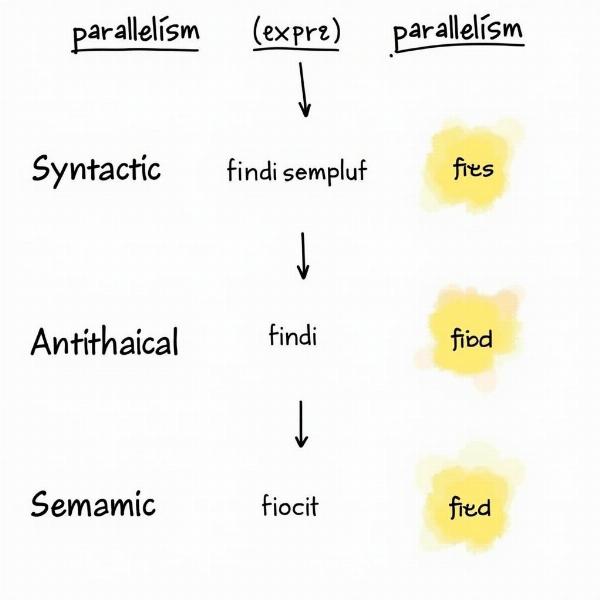Parallelism, a powerful literary and rhetorical device, finds its echo in Hindi as well. Understanding parallelism meaning in Hindi allows us to appreciate the beauty and impact of this technique in various forms of expression, from everyday conversations to sacred texts and literature. This guide explores the different facets of parallelism in Hindi, its significance, and its practical applications.
What Does Parallelism Mean in Hindi?
Parallelism, known as समानांतरता (samaanaantarta) in Hindi, refers to the use of similar grammatical structures, phrases, or clauses in a sentence or series of sentences. This creates a sense of balance, rhythm, and emphasis. Just as parallel lines run alongside each other, parallel structures in language create a harmonious flow and reinforce the meaning. Think of it as a mirroring effect, where the structure of one part of the sentence reflects the structure of another.
Types of Parallelism in Hindi
Parallelism in Hindi, like in other languages, manifests in various forms:
- Syntactic Parallelism: This involves using the same sentence structure repeatedly. For example: वह खाता है, पीता है, और सोता है (Wah khata hai, peeta hai, aur sota hai) – He eats, drinks, and sleeps. The verb-object structure is repeated, creating a rhythmic pattern.
- Antithetical Parallelism: This type contrasts two opposing ideas using parallel structures. For example: जीवन छोटा है, लेकिन कला लंबी है (Jeevan chhota hai, lekin kala lambi hai) – Life is short, but art is long. The contrasting ideas of life and art are presented using similar sentence structures.
- Semantic Parallelism: This uses words with similar meanings in parallel structures to create emphasis. For example: वह खुश, प्रसन्न, और आनंदित था (Wah khush, prasann, aur aanandit tha) – He was happy, joyful, and delighted.
 Illustrating different types of parallelism with Hindi examples
Illustrating different types of parallelism with Hindi examples
Why is Parallelism Important?
Parallelism serves several crucial functions in Hindi:
- Clarity and Emphasis: It clarifies the relationship between ideas and emphasizes key points by presenting them in a balanced and structured way.
- Memorability and Rhythm: The repetitive nature of parallel structures makes them easier to remember and creates a pleasing rhythm.
- Emotional Impact: Parallelism can heighten the emotional impact of a message, especially in poetry and speeches.
- Aesthetic Appeal: It enhances the beauty and elegance of language, making it more engaging and impactful.
Examples of Parallelism in Hindi Literature and Everyday Speech
From the verses of Kabir to the dialogues of Bollywood films, parallelism is woven into the fabric of Hindi expression. In literature, it adds depth and resonance to poetry and prose. In everyday conversations, it adds clarity and impact to our words.
Expert Insight: Dr. Anita Sharma, a renowned Hindi linguist, notes, “Parallelism is not merely a stylistic device; it is a reflection of the inherent symmetry and balance we seek in our understanding of the world.”
Conclusion
Parallelism, or समानांतरता, is a powerful tool that enhances the clarity, impact, and beauty of Hindi language. By understanding its various forms and applications, we can appreciate its significance in both literary and everyday communication. From adding rhythm to our poetry to emphasizing key points in our conversations, parallelism plays a vital role in how we express ourselves.
FAQ
- What is the Hindi word for parallelism? The Hindi word for parallelism is समानांतरता (samaanaantarta).
- How does parallelism improve writing? Parallelism improves writing by creating clarity, emphasis, rhythm, and aesthetic appeal.
- Where can I find examples of parallelism in Hindi? You can find examples of parallelism in Hindi literature, poetry, speeches, and even everyday conversations.
- Is parallelism only used in formal writing? No, parallelism can be used in both formal and informal writing, as well as in spoken language.
- What is the difference between syntactic and semantic parallelism? Syntactic parallelism involves using the same sentence structure, while semantic parallelism uses words with similar meanings in parallel structures.
- How can I use parallelism effectively in my own writing? Practice identifying and using parallel structures in your sentences and pay attention to the rhythm and balance of your language.
- Why is understanding parallelism important? Understanding parallelism helps you appreciate the nuances of Hindi language and improves your communication skills.
About Meaning-Hindi.in
Meaning-Hindi.in is your one-stop solution for all your Hindi translation needs. We offer a wide range of professional translation services, including business and commercial document translation, certified and legal document translation, technical and user manual translation, website and localization services, educational and academic document translation, express translation, and specialized translation services. Our expert team ensures accuracy, cultural sensitivity, and timely delivery. For all your translation needs, contact us at [email protected] or call us at +91 11-4502-7584. Let Meaning-Hindi.in be your bridge to connect with the Hindi-speaking world!